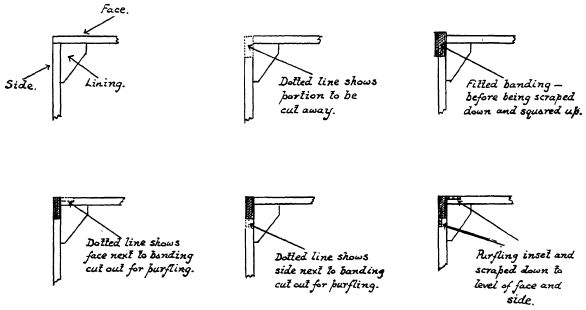Make Your Own Spanish Guitar - online book
Complete plans & Instruction on how make your own Spanish Guitar.
| Share page | Visit Us On FB |
|
26 |
|||
|
|
|||
|
Place a 3/8" high flat piece of wood on the face of the guitar where the bridge will even�tually be fitted�this position can be ascer�tained by measuring the distance from nut to where the neck joins the body and marking this same distance (from where the neck joins the body) on the face of the guitar.
Another small piece of wood f" high placed where the nut will be fitted will give the second point for testing. Hold the straightedge or a taut piece of string between these two pieces of wood and the clearance above where the neck joins the body should not more than 3/8". When the fingerboard is finally fitted to the neck it will give a final string clearance at the twelfth fret of about \'.
The dovetail groove in the top block and the dovetail on the end of the neck are chiselled away, little by little, until the cor�rect set of the neck is secured.
During this operation, constantly check that the centre line of the neck follows the centre join of the guitar face.
The neck should be bedded down to within a little more than 3/8" of the back of the guitar, to allow for a piece of ebony to be glued on to "finish" the base of the heel.
When you are certain that (a) you have a good dovetail joint; (b) the centre of the |
neck follows the centre join of the guitar face; (c) that the " set" of the neck gives the correct string clearance where the neck joins the body�you can then put the neck on one side and proceed to the fitting of the banding and purfling to the front and back edges of the guitar body.
FITTING THE BANDING
The fitting of banding and purfling to the front and back edges of the guitar body is an operation for which you need a cutting gauge first set to J". With this tool, cut away the edge of the front of the guitar to a rebate (see Fig. 28). This rebate should be about the thickness of the sides of the guitar�not more.
When this rebate has been made true with a small chisel and cleaned up, a band of sycamore or other hard wood of contrasting colour to the sides of the guitar is fixed in with glue.
It might be found easier to bend this banding into shape first on the bending iron.
When it is fitted to the guitar it can be kept in position whilst the glue is setting by binding tape or soft string across and right round the body of the instrument.
Two lengths of banding will be re- |
||
|
|
|||
 |
|||
|
|
|||
|
Fig. 28.�Details of the method of fitting the banding and purfling to the front and back edges of the guitar. |
|||
|
|
|||